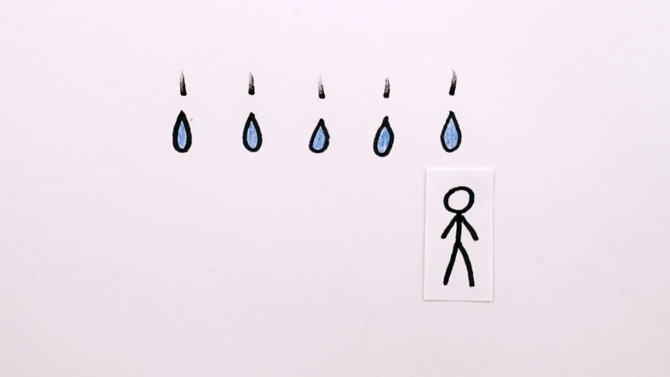When it comes to rain, running or walking is the least wet?
Many people wonder if we should run or walk under the rain to wet at least. Let's find the answer through the article below!
- Can you get a jerk, even death if you pee the power line?
- If the atomic bomb exploded in the ground, what horrible thing would happen?
- If shot, did you hear the first explosion or hit the previous bullet?
The hypothesis is that the rain speed is constant, the distance of travel is fixed. We will only focus on analyzing the horizontal and vertical rainfall falling into people.

When moving, you avoid this rain drop and you will meet another rain drop.
One thing is for sure, when you move, you avoid a drop of rain, another drop of rain will fall on you. That is, whether you stand still or go, it is calculated vertically, in the same period of time the rainfall falls. And of course, the longer you stand in the rain, the more rain will fall on you.

However, if the hypothesis is that the rain drops suddenly stand still, while you and the ground will move straight up, through the raindrops. At that time, no matter how quickly or horizontal you move, the rainfall falls on you every second. The reason is that the box-shaped volume (3D parallelogram) does not depend on its tilt.
So, if you stand still, you will only get the rain falling from the top, and when you run, you will experience rain drops from the side and of course you will get wet.
But if you're trying to go from point A to B, you need to move. At that time, in addition to the vertical rain, you have to catch more horizontal rain, the rain poured in the face.

At the same time, the amount of rain falling on the head is the same whether you go fast or slow.
We will calculate the total amount of rain falling on people by the formula: (the amount of water falling per second multiplied by the time you move under the rain) plus (the amount of water across each meter multiplied by the distance you move).

But according to the first hypothesis, we have a fixed travel distance, the amount of rain is constant, so we need to minimize the amount of rain falling on the head to keep it dry.
In short, when you meet the rain, run out of the rain as quickly as possible.
You should read it
- Summarize the best moods about rain
- The most mysterious and mysterious animal rains in the world
- Full HD rain wallpaper for those you are sad
- Do you know the rain that releases 800,000 trillion ground bacteria into the air
- Harm when leaving the car outside in the rain
- Hold your breath and watch Kinetic Rain, a 1-0-2 dynamic sculpture at Singapore's airport
- Steps to make rain in Photoshop look lifelike with just a few taps
- Risk of Rain 2 tips for beginners
- 4 ways to take photos with rain give the picture more romantic part
- Mysterious town suffers from 'fish rain' every year, scientists are 'at a loss'
- Experience traveling safely into the rain for the near-sighted people
- Strange weather phenomena can only be seen in the universe
May be interested

Stun with automatic cooking lines without Japanese cooks

This is the only part of the body that never 'goosebumps'.

Exotic metal knows 'transformations' back to the original shape no matter how deformed

Discover the secret behind the 'horror' sword swallowing magic

Why is Friday 13th considered 'unlucky day'?

6 habits millions of people are doing wrong every day without realizing






 Summarize the best moods about rain
Summarize the best moods about rain Full HD rain wallpaper for those you are sad
Full HD rain wallpaper for those you are sad Do you know the rain that releases 800,000 trillion ground bacteria into the air
Do you know the rain that releases 800,000 trillion ground bacteria into the air How does footwear affect the way people walk?
How does footwear affect the way people walk? Walking is good but how and how much to lose weight effectively?
Walking is good but how and how much to lose weight effectively? The most mysterious and mysterious animal rains in the world
The most mysterious and mysterious animal rains in the world